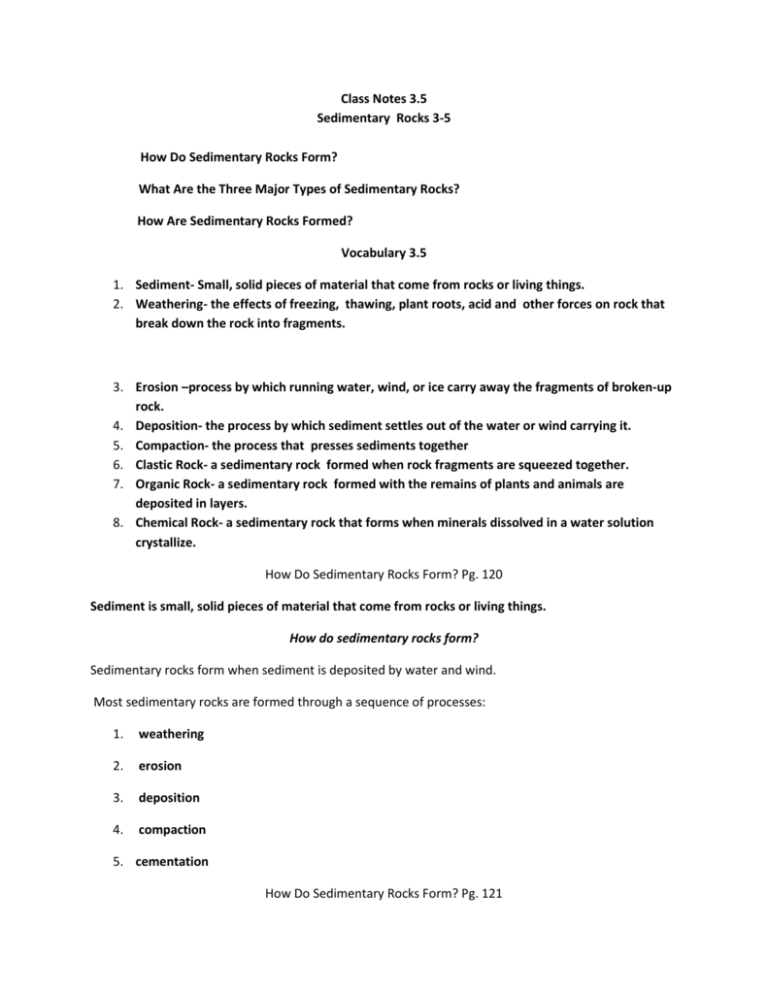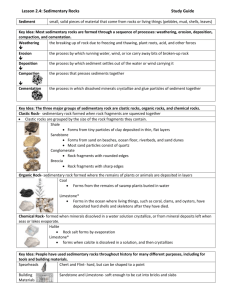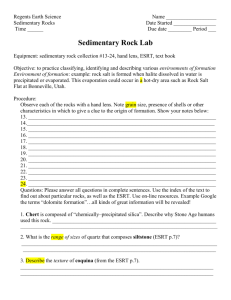File - Ms. D. Science CGPA
advertisement

Class Notes 3.5 Sedimentary Rocks 3-5 How Do Sedimentary Rocks Form? What Are the Three Major Types of Sedimentary Rocks? How Are Sedimentary Rocks Formed? Vocabulary 3.5 1. Sediment- Small, solid pieces of material that come from rocks or living things. 2. Weathering- the effects of freezing, thawing, plant roots, acid and other forces on rock that break down the rock into fragments. 3. Erosion –process by which running water, wind, or ice carry away the fragments of broken-up rock. 4. Deposition- the process by which sediment settles out of the water or wind carrying it. 5. Compaction- the process that presses sediments together 6. Clastic Rock- a sedimentary rock formed when rock fragments are squeezed together. 7. Organic Rock- a sedimentary rock formed with the remains of plants and animals are deposited in layers. 8. Chemical Rock- a sedimentary rock that forms when minerals dissolved in a water solution crystallize. How Do Sedimentary Rocks Form? Pg. 120 Sediment is small, solid pieces of material that come from rocks or living things. How do sedimentary rocks form? Sedimentary rocks form when sediment is deposited by water and wind. Most sedimentary rocks are formed through a sequence of processes: 1. weathering 2. erosion 3. deposition 4. compaction 5. cementation How Do Sedimentary Rocks Form? Pg. 121 Rock on Earth’s surface is constantly broken up by weathering—the effects of freezing and thawing, plant roots, acid, and other forces on rock. After the rock is broken up, the fragments are carried away as a result of erosion—the process by which running water, wind, or ice carry away bits of broken-up rock. Deposition is the process by which sediment settles out of the water or wind carrying it. The process that presses sediments together is compaction. Cementation is the process in which dissolved minerals crystallize and glue particles of sediment together. What Are The Three Major Types Of Sedimentary Rocks? Geologists classify sedimentary rocks according to the type of sediments that make up the rock. The 3 major groups of sedimentary rocks are: Clastic rocks Chemical rocks Organic rocks . Clastic Sedimentary Rocks – pg 122 Clastic Rock • A sedimentary rock formed when rock fragments are squeezed together. • The fragments size vary from clay particles that are too small to see without a microscope to large heavy boulders. How are Clastic rocks classified? by the size of the rock particles that make them up. SOME COMMON CLASTIC ROCKS ARE: SHALE -Which forms from tiny particles of clay which water deposits in thin flat layers SANDSTONE-Which forms from sand on beaches, the ocean floor, dunes CONGLOMERATE- forms from rock fragments that have rounded edges BRECCIA- Forms from rock fragments that have sharp edges riverbeds and sand Organic Sedimentary Rocks pg. 123 Organic rock • A sedimentary rock that forms where the remains of plants and animals are deposited in layers. • Organic means substances that were once living or that were made by living things. SOME COMMON ORGANIC ROCKS ARE: COAL -which is made from the remains of swamp plants buried in water. As layers build up, the weight squeezes the decaying plants together. Over millions of years they slowly change into coal. LIMESTONE- Which forms in the ocean, where coral, clams, and oysters have hard shells or skeletons made of the mineral calcite. When they die, their shells pile up and over millions of years, compaction and cementation change the thick sediment into limestone. Chemical Sedimentary Rocks pg. 124 Chemical rock forms when minerals dissolved in a water solution crystallize. SOME COMMON CHEMICAL ROCKS ARE: LIMESTONE-forms when calcite that is dissolved in lakes, seas, or underground water comes out of a solution and creates crystals. ROCK SALT- made from the mineral halite which forms by evaporation.









